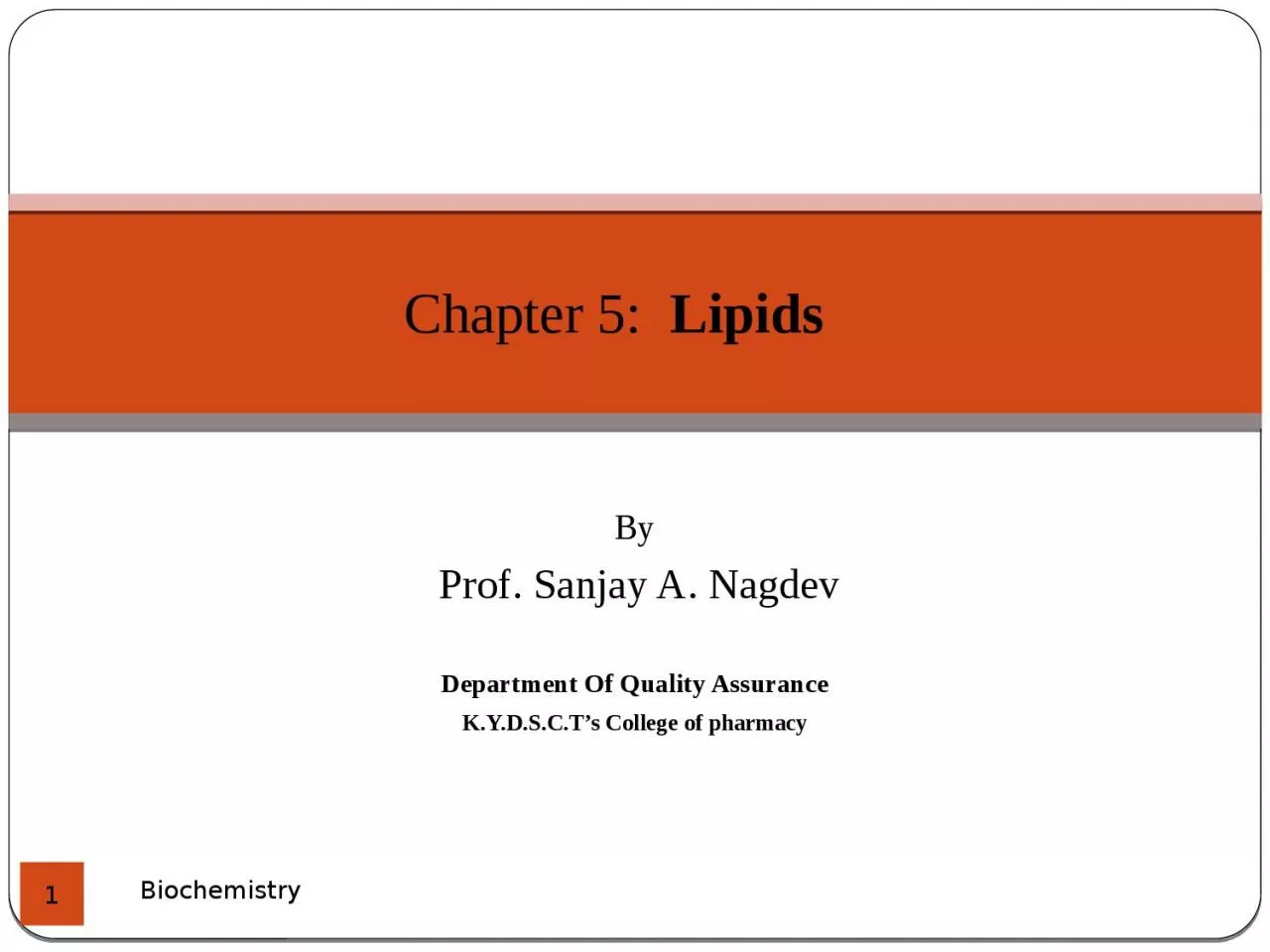

Department Of Quality Assurance KYDSCTs College of pharmacy 1 Chapter 5 Lipids Biochemistry Biochemistry 2 Lipids The lipids are a heterogeneous group of compounds including fats oils steroids ID: 916383
Download Presentation The PPT/PDF document "B y Prof. Sanjay A. Nagdev" is the property of its rightful owner. Permission is granted to download and print the materials on this web site for personal, non-commercial use only, and to display it on your personal computer provided you do not modify the materials and that you retain all copyright notices contained in the materials. By downloading content from our website, you accept the terms of this agreement.
Slide1
By Prof. Sanjay A. NagdevDepartment Of Quality AssuranceK.Y.D.S.C.T’s College of pharmacy
1
Chapter 5: Lipids
Biochemistry
Slide2Biochemistry2Lipids: The lipids are a heterogeneous group of compounds, including fats, oils, steroids, waxes etc.Lipids are insoluble in water.Soluble in non-polar solvents such as ether, benzene, and chloroform.Lipids are Hydrophobic in nature.On hydrolysis yield fatty acids which are utilized by living organisms.Lipids are widely distributed throughout the plant and animal kingdom.In plant the occur in seeds, nuts and in fruits.In Animals they are stored in Adipose tissues nervous tissues etc.
Slide3Functions of lipids:Biochemistry3Lipids are Storage form of energy.Important dietary components because of their high energy value.(Calories)Structural components of Biomembranes.Serve as thermal insulators in the subcutaneous tissues and around certain organs.Combinations of lipid and protein (lipoproteins) are important cellular constituents
, occurring both in the cell membrane and in the mitochondria.
Slide4Clinical significance of Lipids:Biochemistry4 Following diseases are associated with abnormal chemistry or metabolism of lipids-ObesityAtherosclerosisDiabetes MellitusHyperlipoproteinemiaFatty liver etc.
Slide5Biochemistry5
Slide6Fatty acids:Biochemistry6Fatty acids are aliphatic carboxylic acidsHave the general formula R-(CH2)n-COOHFatty acids that occur in natural fats are usually straight-chain derivativesThe chain may be saturated (containing no double bonds) or unsaturated (containing one or more double bonds).
Slide7Classification of fatty acids: According to natureBiochemistry7a) Saturatede.g. Acetic acid, Butyric acid, Caproic acid.b) Unsaturated1.Monosaturated (mono-enoic): e.g. oleic acid
2.Poly unsaturated (Poly-enoic):e.g. α-Linolenic acid
c) Branched chain fatty acidse.g. Phytanic acidd) Substituted Fatty acidse.g. Cerebronic acide)
Cyclic fatty acids-
e.g.
Hydnocarpic acid
Slide8Classification of fatty acids: According to length of chainBiochemistry81.Short chain- with 2-6 carbon atoms2.Medium chain- with 8-14 carbon atoms3.Long chain- with 16-18 carbon atoms 4.Very long chain- with 20 or more carbon atoms
Slide9Biological role of fatty acidsBiochemistry9Fatty acids are the building blocks of dietary fats.Fatty acids are also required for the formation of membrane lipids such as phospholipids and glycolipids.They act as fuel molecules and are oxidized to produce energy.
Slide10Biochemistry10Acid Value/Acid Number: it is the number of milligrams of Potassium hydroxide required to Neutralize the free fatty acids in 1 gram of oil/ fat.[Note: High acid value indicates the storage of oil/fat under improper conditions.]Saponification value/ Saponification number: it is the number of milligrams of potassium hydroxide required to completely saponify the 1 gram of oil/fat.[Note: Saponification value gives us the idea about the molecular weight of oil/fat .]
Slide11Biochemistry11Iodine value/ iodine Number: It is the number of grams of iodine the that combines with 100 gm of oil/fat.[Note: Iodine number gives us the idea about the degree of unsaturation in oil/fat]Rancidity: oxidation or Chemical Decomposition of oils/ Fats is called as Rancidity. rancid product becomes unfit for consumption and have bad taste and odour.
Slide12Cholesterol:Biochemistry12Most important sterol inhuman bodyMolecular formula-C27H45OHPossesses a cyclo-pentano-per-hydro-phenatherene ring nucleusHas an -OH group at C3A
double bond between C5and C6 Two- CH3 groups at C
10 and C13An eight carbon side chain attached to C17
Slide13Biochemistry13Normal level of serum total cholesterol ranges between 150-220 mg/dL (deciliter)Pathological Variations-A) Low cholesterol (Hypocholesterolemia)- results in anemia, hemolytic jaundice, malabsorption syndrome.B) High Cholesterol (Hypercholesterolemia)- results in Nephrotic syndrome, Diabetes Mellitus and Atherosclerosis.